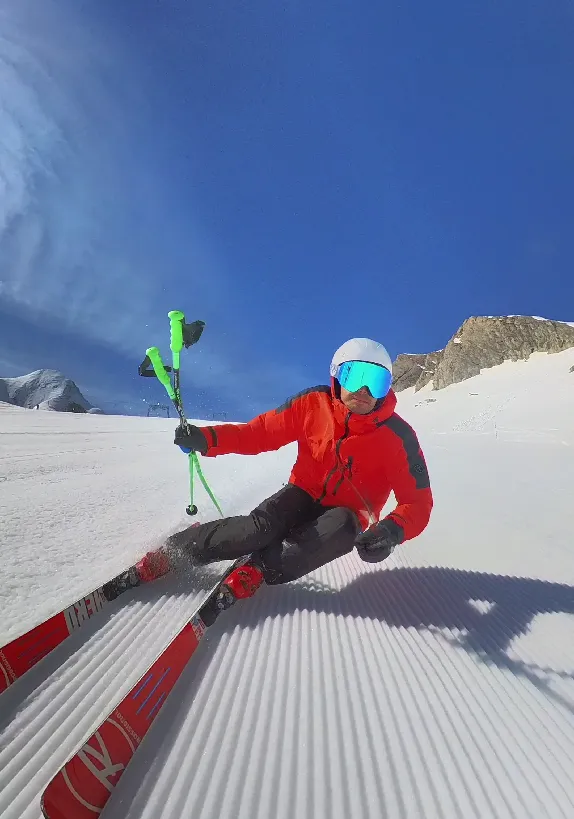Blog

Edging versus Pivoting
Understanding the nuances between edging and redirecting is fundamental to advancing your skiing technique. Both approaches serve different purposes and are suitable for varying conditions and styles. Here is a detailed breakdown of the key differences:
Ski Turns You vs. You Turn the Ski:
Edging: When you edge, the ski's design and shape assist in turning. The skier sets the edge, and the ski naturally follows its arc due to the sidecut and camber.
Redirecting: Here, you actively pivot the ski. This means you exert effort to turn the ski independently of its natural shape.
Turn Initiation:
Edging: Higher edge angle early in the turn, with the turn starting later in the arc due to the ski's gradual bend.
Redirecting: Engages the turn almost immediately through the pivot action.
Fall Line Engagement:
Edging: Involves skiing more in the fall line, maintaining the ski’s edge longer, which engages the ski's shape to make the turn.
Redirecting: Less engagement with the fall line, as you quickly pivot the skis to change direction.
Timing and Patience:
Edging: Requires better timing, more patience, and better balance on the outside ski to maintain the edge through the turn.
Redirecting: Less need for patience, higher turn initiation possible, as the pivoting action is not reliant on utilizing the hourglass ski design.
Ski Shape vs. Muscle:
Edging: Utilizes the natural shape and design of the ski for turning.
Redirecting: Relies on the skier’s muscle to pivot and maneuver the skis.
Ski Flex and Angles:
Edging: Bends the ski more and involves higher edge angles.
Redirecting: Less bending of the ski, with lower edge angles involved.
Control at Higher Speeds:
Edging: Offers more control at higher speeds, as the ski is consistently engaged with the snow.
Redirecting: Can be less stable at higher speeds due to the abrupt changes in direction.
Turning Forces and Fatigue:
Edging: Potential to generate more turning forces, leading to potential fatigue at higher speeds due to the increased demands.
Redirecting: Edging is less fatiguing at lower speeds as it’s more isometric, while redirecting might require slight eccentric/concentric movements, increasing physical exertion.
Surface Grip:
Edging: Provides better grip on firmer snow and ice due to the continuous edge engagement.
Redirecting: May struggle for grip on hard surfaces, as the pivoting action doesn't utilize the edge as effectively.
Balance and Body Movement:
Edging: More isometric, relying on steady balance over the edges.
Redirecting: Involves more dynamic movements. Rotary/pushing/pivoting requires shifting the upper body more to the outside to stay balanced on the outside ski.
Body Positioning:
Edging: Allows you to be more centered over the skis. This balanced stance leverages the ski's design to initiate and sustain the turn.
Redirecting: A more forward stance will be rewarded. Lightening the tails helps in pivoting and washing out the skis for direction changes.
Recentering Techniques:
Edging: You can use a foot pullback to recenter, allowing for smoother transitions and maintaining a balanced stance.
Redirecting: Requires an up-and-forward move to recenter, which involves more pronounced movements and adjustments.
Recentered Position: At lower speeds redirecting/pivoting will affecting fore/aft balance more than edging, which requires for more recentering
If you found this post on the intricacies of edging and redirecting insightful, there's so much more to explore! Join us for exclusive access to expert tips, personalized coaching, and a community of passionate skiers. Elevate your skills and stay ahead of the curve. Visit our website today and start your journey to skiing excellence!
Follow Us on Instagram
Get In Touch
Email: [email protected]
Address
Office: Lorem Ipsum, XX, 12345
Assistance Hours
Mon – Sat 9:00am – 8:00pm
Sunday – CLOSED
Phone Number:
xxx-xxx-xxxx

